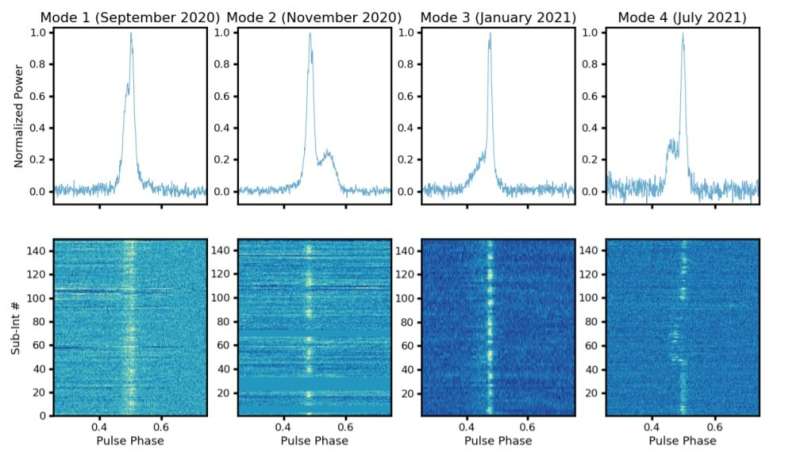The four different radio emission modes of Swift J1818.0-1607 that were identified. The bottom panel shows 8-second subintegration timeseries for each emission mode at 1.4 GHz observed with the Lovell telescope. The top panel shows the resulting average profile formed from the timeseries shown in the bottom panel. Credit: Rajwade et al., 2022.
An international team of astronomers has performed long-term radio and X-ray observations of a recently detected young magnetar known as Swift J1818.0-1607. Results of the monitoring campaign, published February 15 on arXiv.org, deliver important insights into the properties and evolution of this source.
Magnetars are neutron stars with extremely strong magnetic fields, more than a quadrillion times stronger than the magnetic field of our planet. Decay of magnetic fields in magnetars powers the emission of high-energy electromagnetic radiation, for instance, in the form of X-rays or radio waves.
Discovered in 2020 with NASA's Swift spacecraft, Swift J1818.0-1607 is a magnetar showcasing X-ray pulsations with a period of 1.36 seconds. The object was also detected at radio wavelengths, which makes it only the fifth radio-loud magnetar known to date. With a characteristic age estimated to be between 250 and 1,000 years, Swift J1818.0-1607 is one of the youngest magnetars so far identified.
Since its bright X-ray outburst in 2020, Swift J1818.0-1607 has experienced large variations in its spin-down behavior. The observations of this magnetar show the radio emission exhibits large variability and that the source showcases a mode change phenomenon as the radio emission abruptly changes with a corresponding change in the pulse shape. Although short timescale properties of Swift J1818.0-1607 have been investigated, no long-term study of this magnetar has been conducted yet.
Therefore, a team of astronomers led by Kaustubh Rajwade of the University of Manchester, UK, has performed a long-term monitoring campaign of Swift J1818.0-1607 using the 76-m Lovell radio telescope and the 26-m MkII telescope, both located Jodrell Bank, UK.
"Swift J1818.0-1607 has been regularly observed at radio and X-ray wavelengths over the span of about one year since the outburst. This provides a chance to study the quasi-simultaneous evolution of the radio and X-ray emission of the magnetar since the outburst. Here, we present the evolution of the radio and X-ray emission of Swift J1818.0-1607 over the span of one year as the magnetar transitions to quiescent X-ray flux levels," the researchers wrote in the paper.
The study found that the radio emission of Swift J1818.0-1607 evolves over time and can be characterized by distinct modes defined by distinct radio profile shapes and emission. The long-term monitoring of this magnetar revealed similar modes that are characterized by the change in the modulation index of the spin frequency derivative about a nominal value of approximately 0.0137 nHz/s.
Furthermore, the time of the transition between two radio modes in Swift J1818.0-1607 is correlated to the time of transition in the mode of the spin frequency derivative. This, according to the astronomers, indicates a change in physical conditions of the magnetosphere similar to what is seen in other mode-changing canonical pulsars. The researchers added that these results support the hypothesis pointing out to a physical link between canonical pulsars and radio-loud magnetars and suggest that the radio emission in them are different manifestations of the same emission mechanism.
"Our study shows that the radio emission in magnetars can be quite similar to the emission seen from radio pulsars and Swift J1818.0-1607 might be the link that connects the two sub-populations of neutron stars," the authors of the paper concluded.
More information: Long term radio and X-ray evolution of the magnetar Swift J1818.0-1607, arXiv:2202.07548 [astro-ph.HE] arxiv.org/abs/2202.07548
© 2022 Science X Network
























